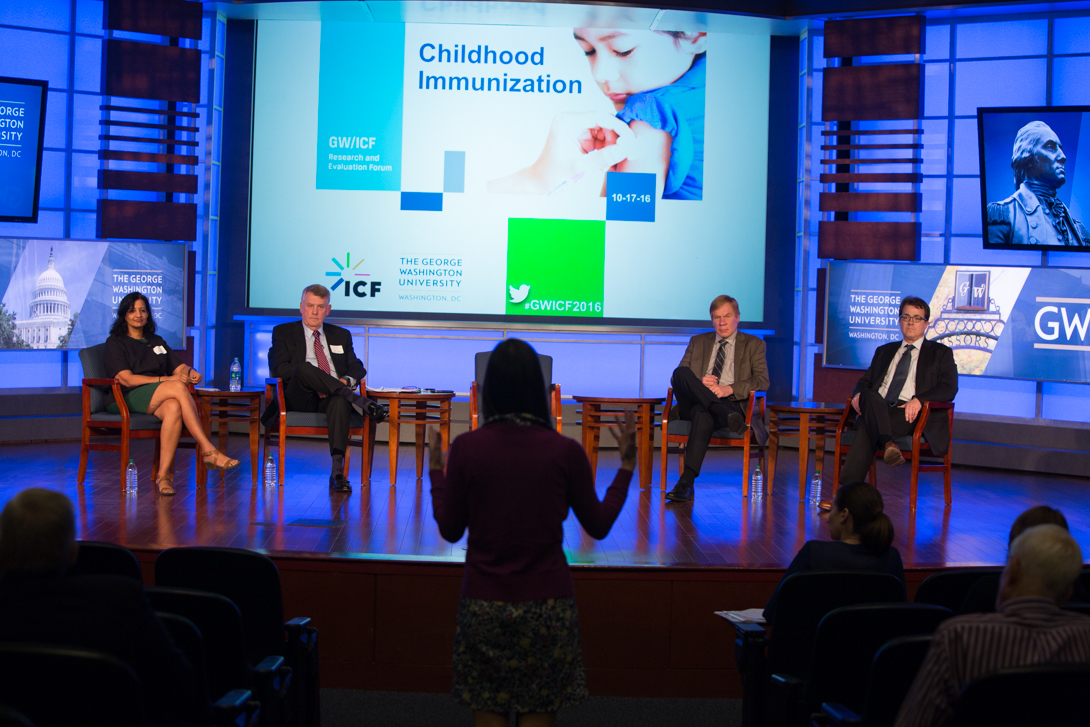By B. L. Wilson
Childhood immunizations have proven to be effective, but many parents still wonder whether the vaccines compromise children’s health in the long term, according to Robert Miller, senior associate dean for research at the George Washington University School of Medicine and Health Sciences.
Dr. Miller gave opening remarks to an audience and a group of experts from industry, government and academia convened by GW’s Office of Industry and Corporate Research, which is part of the Office of the Vice President for Research, to discuss the underlying disparities in immunizing children. Tuesday’s panel at Jack Morton Auditorium was the sixth research and evaluation forum that GW has conducted with corporate partner ICF International, a research and consulting firm.
A recent survey by the federal Centers for Disease Control and Prevention says that the vast majority of parents are following recommendations for vaccinating children up to the age of 6. In 2015, more than 90 percent of children were up to date on scheduled vaccines.
Still, worrisome disparities in vaccinations rates exist, said Glen Nowak, director of the Center for Health and Risk Communication at the University of Georgia.
“Children in poorer often rural areas were missing recommended vaccines,” he said. “That may be because of the lack of health care or the lack of awareness of parents.”
It’s not just poor children who are missing vaccines. He said a number of studies show between 4 percent and 23 percent of parents try to manage or delay scheduled vaccines.
Anjali Jain, a vice president at the Lewin Group, a health care consulting group, described the arguments of parents who want to control how many shots their children get.
“’These are too many things together. They’re all at the same time. There’s too many shots, and we want to spread it out,’” Dr. Jain said.
She said most parents have been persuaded that there’s no evidence linking vaccinations and autism, but there are reports that 10 percent remain skeptical about whether the science around the issue has been settled.
“You’re getting your child a shot. It hurts. They’re screaming bloody murder in the clinic, and then in two months they’re getting another one,” Dr. Jain said. “And that’s when development disorders, autism, speech delays are rising at the same time.”
Kevin Pelphrey, director of GW’s Autism and Neurodevelopmental Disorders Institute and the Carbonell Family Professor in Autism and Neurodevelopmental Disorders, has researched the brain functions affected by autism.
“As far as an issue can be settled, it is settled,” Dr. Pelphrey said.
“Public health data, genetics and neuroscience data suggests that autism begins to emerge during prenatal development, The papers that claimed to show a link between autism and vaccines were retracted because they were fraudulent.."he said. “There’s really not anything else that science can do to help refute the persistent claims.”
The challenge to changing this perception is in explaining the mechanisms for the risk of developing autism that include a multiplicity of genetic causes compounded by environmental factors.
“The minute you say that [environmental factors], people jump to vaccines, but vaccines are not one of the environmental risk factors being considered today. Instead, factors such as exposure to pollution and parental age are the current focus,” Dr. Pelphrey said.
Panel moderator Lisa Guay-Woodford, associate vice president for clinical and translational research and a professor of pediatrics at SMHS, said that it can be hard for parents to separate medical reality from their experiences, which is that their child got 14 shots in the first years of life. She asked what experts could do to motivate parents to comply.
John Boyle, senior vice president of ICF, which conducts large-scale surveys for federal agencies, explained that it is not just about providing information. Trust, he said, is key to compliance.
In the 1950s, there were three TV channels and most people in this country trusted the government. Now, he explained, trust among Republicans and Democrats alike is down to 10 percent and 20 percent, respectively. Mr. Boyle attributed that nosedive in trust among people in the United States to the many more sources of information available to a relatively well-informed public.
“People are free to believe what they choose to believe,” Mr. Boyle said. “We can’t call it confusion because people feel very strongly about what they believe.”
Members of the panel agreed that in this environment scientists and the medical community must communicate more effectively.
Drs. Jain and Pelphrey both mentioned that parents often turned to them as authorities for assurances that vaccinations are safe. That process comes with limitations. Too many doctors are unable to devote 15 minutes to answering questions from the parent of a single patient.


